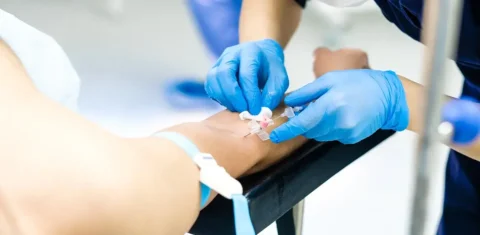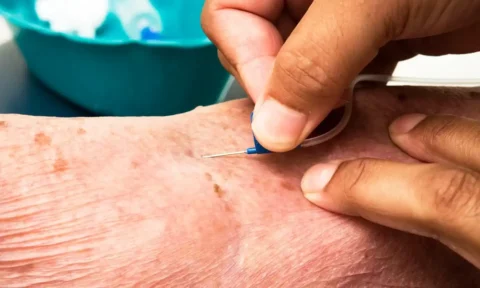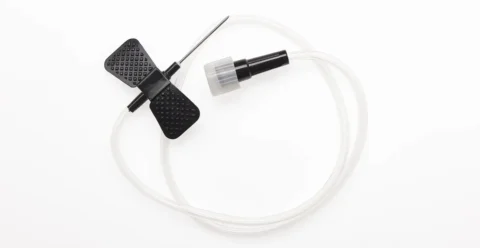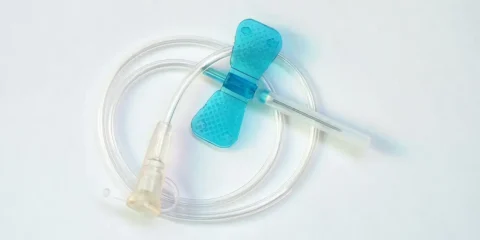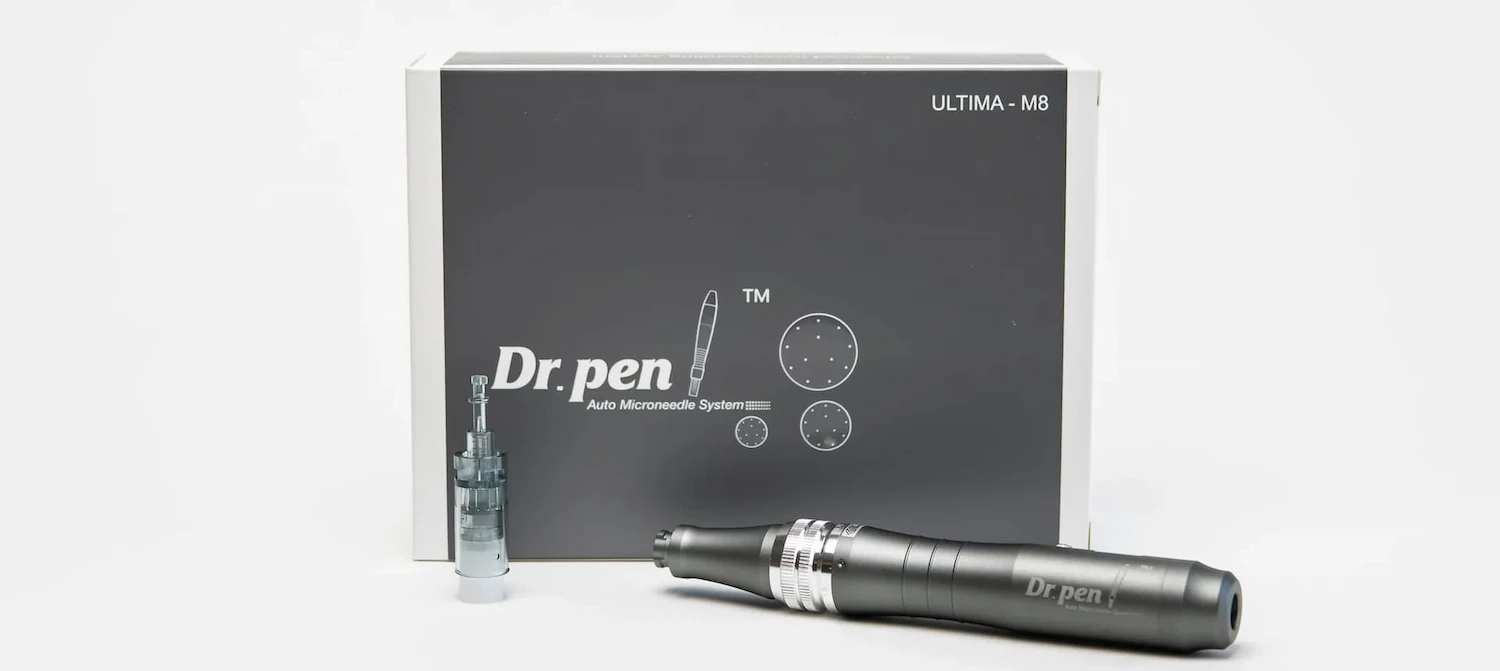Subcutaneous liquid infusion with a butterfly needle or winged infusion set is one of the options for medication administration because it’s easy to use, involves minimal pain, and can stay in place for up to 14 days, depending on the type of medicine. This medical device is also used for blood collection and IV therapy. Because a winged infusion set is a bit different from the typical straight needles, there are specific ways for inserting it properly
So how should you insert subcutaneous butterfly needles? After preparing the infusion set, medications, and injection site, hold the plastic wings together with your thumb and index finger, ensuring that the textured portion of the plastic wings is facing down. Pinch the skin at the injection site and insert the needle at a 30 to 40° angle, ensuring it enters the subcutaneous tissue or fatty layer between the skin and muscles.
What Your Butterfly Needle Set Includes
A butterfly needle, also called a winged infusion set, is a medical device with a tiny needle and two plastic flaps on either side. It’s also used for administering fluids into the body or extracting a blood sample via the intravenous route.
As a device for subcutaneous infusion, a butterfly needle is usually preferred for medication administration for patients in the palliative care unit when they could no longer take their medicine by mouth. The set is easy to insert and can stay inserted for up to 14 days. It’s also not painful for the patient due to the small needle. Your butterfly needle for subcutaneous infusion includes the following:
- A 23 to 25-gauge needle
- 2 flexible plastic flaps or wings
- A plastic transparent tubing
- A connecter
During subcutaneous fluid infusion, you must prepare all the needed tools and have them within arm’s reach to avoid infections, injury, and other accidents. Some of the equipment you must have prepared before performing the SC injection are:
- 23 to 25-gauge winged infusion set
- Chlorhexidine 2% solution or 70% isopropyl alcohol swab for disinfecting the infusion site
- Tape
- Latex-free, non-sterile gloves
- Needleless butterfly syringes containing the medication, sealed with a LuerLock
- Extra 0.4 mL of the medicine for preparing the tubing set and needle during the initial insertion
- IV connector without needles
- Transparent dressing for securing the needle and syringe
These are the basic tools you’re going to need for subcutaneous infusion. The details may still differ depending on the patient’s treatment plan and the policies in your practice. You must ensure that your tools are complete, so you’ll have a safe and efficient subcutaneous fluid therapy administration.
How to Insert Subcutaneous Butterfly Needle
Subcutaneous administration using a butterfly needle can be tricky for some medical professionals, especially if they’re still starting their careers. This device is different from other needles that you can hold with more fingers. Butterfly needles are easier to use because they allow optimal motor control as you grip them close to the needle tip. The steps for performing a subcutaneous injection with a butterfly needle are as follows:
- Ensure the patient and the medication to inject via subcutaneous administration.
- Gather the necessary tools for conducting subcutaneous medication.
- Perform necessary steps for hand hygiene.
- Wear clean, latex-free, and non-sterile gloves.
- Choose the infusion site.
- Clean the infusion site with an isopropyl alcohol swab or a chlorhexidine solution in circular motions around 5 to 8 cm around the area.
- Remove the butterfly needle’s slide clamp if it’s not needed after the insertion.
- Unfasten the needle’s vent plug.
- Attach to the Y port the needleless connector or LuerLock.
- Prep the winged infusion set by filling the syringe with the needed medication, with an extra 0.4mL for setting up the device.
- Loosen the butterfly needle by rotating its white safety shield at 360º.
- Ensure the set’s bevel is up and avoid the catheter covering the needle tip.
- Hold the needle by pinching the two plastic flaps together, keeping the textured surface downwards.
- Pinch the skin and insert the butterfly needle at a 30 to 45º angle to the needle’s full length, ensuring the needle enters the subcutaneous tissue or the fatty layer between the skin and muscles.
- Release the wings and hold them flat on the skin with your non-dominant hand.
- Pull out the white safety shield with your dominant hand and leave the cap
- Release the needle
- Apply the transparent dressing and secure it in place. You may apply a gauze under the set’s port to prevent skin irritation or discomfort from the pressure
- Attach primed IV connector
- Administer 0.28 cc into the set’s line by flushing it with a 3 cc syringe pre-filled with fluid
- Apply a label on the dressing, indicating the:
- Name of the medication with dose or concentration
- Insertion date and time
- Initials of administrator
- Clinical designation of administrator
22. Ensure recording the insertion of the continuous subcutaneous infusion on your report, including the following information:
- Date and time of insertion
- Concentration of medication
- Dose of medication
- Route
- Injection site
- Catheter size
- Site assessment
- Response of patient to the insertion
- Practitioner conducting the insertion of the catheter and medication
These are the steps to performing a subcutaneous injection with a butterfly needle. Ensure that you remember these steps and receive the utmost training and practice to avoid adverse effects.
How to Prime a Butterfly Needle
Before inserting the butterfly needle into the subcutaneous tissue for medication or IV administration, you mustn’t forget to prime it first. This is necessary for extraction or infusion via the subcutaneous route. To prime your winged infusion set, you must:
- Attach the needle’s tubing to the other end of your tubing’s flow control
- Push the syringe’s plunger until the line is filled with the fluid to prime it and remove air bubbles
- You might want to only prime the set’s line up to the needle’s base – keeping it dry allows easier and more comfortable insertion.
- To prime the springfusor syringe, insert the set’s flow control tubing into the syringe’s tip.
These are some ways to prime your butterfly needle for subcutaneous administration. The butterfly needle is one of the easiest and less painful devices usually used for injecting medication in a palliative care patient. It’s also used for intravenous infusion when doing blood draws or inserting IV fluids. Many practitioners also note how this set can be pretty easy to use with ample practice.
How to Choose the Appropriate Injection Site
Choosing the accurate infusion site for subcutaneous medication with a butterfly needle is necessary for ensuring the patient receives their medication. The subcutaneous route tends to be more suitable for some medicines because it allows a slower diffusion and sustained absorption. In choosing a suitable injection site, remember that it must:
- Have an acceptable subcutaneous tissue depth
- Not be near a joint
- Be easily accessible, like the abdomen or the chest
- Be done by rotation
- Depend on the patient’s state, whether they’re agitated and/or distressed or ambulatory
The abdomen or the chest are some of the most common infusion sites. Some sites aren’t recommended to be inserted with a butterfly needle for medication administration. The areas that shouldn’t be administered with a winged infusion set are those with:
- Bony prominence
- Proximity to a joint
- Lymphedema, or tissue swelling due to accumulation of fluid
- Broken skin
- Skin treated with radiation
- Skin folds
- Inflamed skin
- Infection
- With compromised lymphatic drainage
- Tumor
- Pitting edema or ascites
Before choosing an infusion site for SC injection, healthcare providers usually assess the patient for the best area to insert the butterfly needle for continuous subcutaneous infusion. This step is necessary for setting up the patient’s treatment plan for success and preventing adverse reactions and complications.
The longevity of the butterfly needle’s installation also depends on the injection site and the type of cannula you’ve inserted. You might also want to check out for adverse effects, influenced by factors, like:
- Medication tonicity
- Infection
- pH solution
- A foreign body’s extended presence
- Medications, such as:
- Cyclizine
- Ketamine
- Levomepromazine
- Methadone
- Morphine tartrate
- Promethazine
Because of this, medical professionals usually change the infusion site every 7 days to ensure patency and rotate the sites. This can also prevent tissue damage in the patient. They also ensure inspecting the site regularly to avoid any complications.
What to Check in the Injection Site
Ensuring the infusion site’s normal condition is crucial for promoting the patient’s welfare, especially when they’re receiving their medications via a subcutaneous route. When checking the injection site, you might want to inspect for the following:
- Displacement of the needle or cannula
- Hardness or soreness at the infusion site
- Development of a hematoma
- Leakage at the injection site
- Swelling
- The presence of a sterile abscess, resulting in local tissue irritation
- Erythema or redness
- Presence of blood in the site’s tubing
You must be wary of these signs when inspecting the injection site. Early detection of these adverse effects can mitigate the risks and prevent any complications. You might also want to check the patient regularly by:
- Asking how the patient feels
- Asking if the pain and other symptoms have been controlled
- Ensuring the proper function of the infusion device
- Inspecting the remaining volume in the syringe
- Ensuring there aren’t any leakages
- Ensuring firm connections on the cannula and syringe
These are some things to remember when a patient has a continuous subcutaneous infusion. As mentioned, you must rotate the infusion sites. Since a foreign object is inserted into their bodies for long periods, you must always check for adverse reactions.
How to Manage Complications from Subcutaneous Infusion with Butterfly Needle
Healthcare providers regularly inspect the patient’s continuous subcutaneous infusion to prevent or detect side effects and complications early on. If you spot any complication on a patient’s infusion site, you must:
- Remove the indwelling subcutaneous catheter device
- Insert a butterfly needle at a different site
- Document the complications in the patient’s progress notes
- Inform your superior in case of premature removal and/or reinsertion of the infusion device to discuss the following steps
- Refrain from reinserting the set’s needle if the indwelling subcutaneous catheter device has been withdrawn or dislodged — perform the subcutaneous fluid infusion with a new set.
- Ensure not to bend the needle before inserting it into the subcutaneous tissue
- Avoid reinserting the butterfly needle into the catheter, resulting in shearing
- Avoid using scissors in the area of the indwelling subcutaneous catheter device
These are some protocols to remember if you encounter adverse reactions or complications from a subcutaneous fluid infusion. Early detection is crucial to reduce long-term and serious effects on the patient, so you might want to check the site regularly.
Browse Our Catalog at FACE Med Store for Butterfly Needles and Other Medical and Beauty Supplies
Butterfly needles are used for subcutaneous fluid infusion. Patients in the palliative care unit usually receive their medications through these medical devices because they involve minimal pain due to the size of the needles and can stay in the body for several days. Because of this, learning how to properly insert and manage these needles are crucial for promoting the patient’s welfare. You might want to choose high-quality items for your practice.
FACE Med Store is one of the most trusted brands for providing reliable and high-quality medical and beauty supplies to a wide range of practices, from medical spas to clinics and hospitals. We offer only premium items at competitive prices with the best services. Invest in the best butterfly needles and other supplies for your practice today for optimal quality. Browse our catalog to learn more about our products.
